The indoor rotary high voltage disconnect switch market is projected to expand from USD 139.0 million in 2025 to USD 308.6 million by 2035, at a CAGR of 8.3%, and regional dynamics play a decisive role in shaping demand trajectories. Asia Pacific is expected to account for the largest share, driven by grid modernization in China, India, and Southeast Asia, where rapid renewable integration and industrial expansion necessitate reliable electrical isolation systems. China’s state-backed infrastructure investments and India’s transmission upgrades create consistent demand for high-performance rotary disconnect switches, particularly in indoor substations supporting urban and industrial load centers. North America represents another significant growth hub, with the United States focusing on replacing aging transmission infrastructure and enhancing power resilience against climate-related disruptions.
Demand is fueled by utility-scale grid upgrades, increasing penetration of distributed renewable generation, and advanced safety compliance standards mandated by OSHA and IEEE. Europe is characterized by strong uptake in industrial and grid-scale renewable projects, with Germany, France, and the United Kingdom prioritizing high-voltage component modernization to support offshore wind and decarbonization targets. Stringent EU directives around electrical safety and energy efficiency also encourage the adoption of maintenance-free and compact rotary disconnect systems. The Middle East presents opportunities tied to power reliability in industrial hubs and oil and gas complexes, with Saudi Arabia and the UAE investing heavily in substation modernization and smart grid deployment. Africa, though smaller in scale, demonstrates potential in South Africa, Nigeria, and Kenya, where electrification programs and grid expansion create demand for cost-efficient indoor high-voltage equipment.
Latin America adds incremental growth, led by Brazil and Mexico, where renewable capacity expansion and industrial infrastructure development are translating into increased adoption of advanced switching technologies. Regional disparities are evident in the rate of penetration, with Asia Pacific and Europe moving rapidly due to policy-driven grid upgrades, while North America advances steadily with a mix of replacement demand and new installations. Developing regions face supply-side constraints, particularly in Africa and parts of Latin America, where limited capital investment and high import dependency slow adoption. However, global manufacturers are expanding local assembly and distribution networks to address cost barriers and delivery timelines.
The indoor rotary high voltage disconnect switch market demonstrates distinct growth phases with varying market characteristics and competitive dynamics. Between 2025 and 2030, the indoor rotary high voltage disconnect switch market progresses through its advanced switching technology adoption phase, expanding from USD 139.0 million to USD 191.2 million with steady annual increments averaging 8.1% growth. This period showcases the transition from conventional switching mechanisms to advanced rotary systems with enhanced isolation capabilities and integrated safety monitoring becoming mainstream features.
The 2025-2030 phase adds USD 52.2 million to market value, representing 31% of total decade expansion. Market maturation factors include standardization of voltage specifications, declining material costs for high-performance switching components, and increasing utility awareness of rotary switch benefits reaching 75-80% effectiveness in electrical isolation applications. Competitive landscape evolution during this period features established manufacturers like Hitachi and GE expanding their product portfolios while emerging players focus on specialized ultra-high voltage solutions and enhanced safety technology.
From 2030 to 2035, market dynamics shift toward advanced customization and multi-sector deployment, with growth accelerating from USD 191.2 million to USD 308.6 million, adding USD 117.4 million or 69% of total expansion. This phase transition logic centers on universal high-voltage systems, integration with smart grid equipment, and deployment across diverse power infrastructure scenarios, becoming standard rather than specialized switching formats. The competitive environment matures with focus shifting from basic switching to comprehensive isolation performance and compatibility with modern power management systems.
| Metric | Value |
|---|---|
| Market Value (2025) | USD 139.0 million |
| Market Forecast (2035) | USD 308.6 million |
| Growth Rate | 8.30% CAGR |
| Leading Voltage Range | 245 KV to 550 KV |
| Primary Application | Power Grid Segment |
The indoor rotary high voltage disconnect switch market demonstrates strong fundamentals with 245 KV to 550 KV systems capturing a dominant share through superior switching performance and cost-effective installation capabilities. Power grid applications drive primary demand, supported by increasing transmission infrastructure requirements and enhanced isolation management solutions. Geographic expansion remains concentrated in developed markets with established electrical infrastructure, while emerging economies show accelerating adoption rates driven by grid modernization projects and rising industrial power demand activity.
The indoor rotary high voltage disconnect switch market represents a compelling intersection of electrical infrastructure innovation, switching technology advancement, and power isolation optimization management. With robust growth projected from USD 139.0 million in 2025 to USD 308.6 million by 2035 at an 8.30% CAGR, this market is driven by increasing grid modernization expansion trends, industrial power requirements, and utility demand for reliable switching formats.
The indoor rotary high voltage disconnect switch market's expansion reflects a fundamental shift in how power utilities and industrial facilities approach electrical isolation infrastructure. Strong growth opportunities exist across diverse applications, from power station operations requiring high-voltage switching to distribution networks demanding reliable isolation solutions. Geographic expansion is particularly pronounced in Asia-Pacific markets, led by China (11.2% CAGR) and India (10.4% CAGR), while established markets in North America and Europe drive innovation and specialized segment development.
The dominance of 245 KV to 550 KV systems and power grid applications underscores the importance of proven switching technology and electrical reliability in driving adoption. Voltage handling and manufacturing complexity remain key challenges, creating opportunities for companies that can deliver consistent performance while maintaining cost efficiency.
Market expansion rests on three fundamental shifts driving adoption across utility and industrial sectors. Grid modernization growth creates compelling advantages through disconnect switch systems that provide comprehensive electrical isolation with standardized protection compatibility, enabling utilities to manage increasing power loads and maintain safety standards while ensuring efficient switching operations and justifying investment over basic isolation methods. Industrial facility electrification accelerates as companies worldwide seek reliable power distribution systems that deliver operational efficiency directly to production operations, enabling power quality improvement that aligns with industrial automation expectations and maximizes electrical system productivity. Renewable energy integration drives adoption from power developers requiring robust switching solutions that maximize isolation capacity while maintaining arc-free performance during grid connection and disconnection operations.
Primary Classification: The market segments by voltage range into 33 KV to 245 KV, 245 KV to 550 KV, 550 KV to 765 KV, and Others categories, representing the evolution from medium-voltage applications to ultra-high voltage formats for comprehensive power isolation operations.
Secondary Breakdown: Application segmentation divides the indoor rotary high voltage disconnect switch market into Power Station, Power Grid, Distribution Station, and Others sectors, reflecting distinct requirements for switching capacity, isolation specifications, and safety performance.
Regional Classification: Geographic distribution covers Asia Pacific, North America, Europe, Latin America, and the Middle East & Africa, with developed markets leading innovation while emerging economies show accelerating growth patterns driven by electrical infrastructure development programs.
The segmentation structure reveals technology progression from standard medium-voltage switches toward integrated ultra-high voltage platforms with enhanced isolation and safety capabilities, while application diversity spans from power generation facilities to distribution networks requiring comprehensive electrical switching and fail-safe isolation solutions.
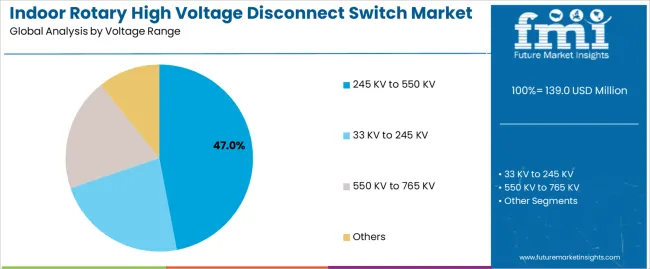
245 KV to 550 KV segment is estimated to account for 47% of the indoor rotary high voltage disconnect switch market share in 2025. The segment's leading position stems from its fundamental role as a critical component in transmission applications and its extensive use across multiple utility and industrial sectors. The 245 KV to 550 KV range's dominance is attributed to its optimal balance between switching capability and installation complexity, including excellent arc interruption, reliable isolation properties, and balanced cost-effectiveness that make it indispensable for high-voltage power system operations.
Market Position: 245 KV to 550 KV systems command the leading position in the disconnect switch market through advanced switching technologies, including comprehensive arc extinction control, uniform contact design, and reliable operation performance that enable manufacturers to deploy isolation solutions across diverse electrical environments.
Value Drivers: The segment benefits from utility preference for proven voltage profiles that provide exceptional switching reliability without requiring ultra-high voltage material costs. Efficient manufacturing processes enable deployment in transmission substations, industrial power systems, and utility applications where switching reliability and cost efficiency represent critical selection requirements.
Competitive Advantages: 245 KV to 550 KV systems differentiate through excellent current-carrying capacity, proven isolation resistance, and compatibility with standard substation equipment that enhance switching capabilities while maintaining economical voltage profiles suitable for diverse power system applications.
Key market characteristics:
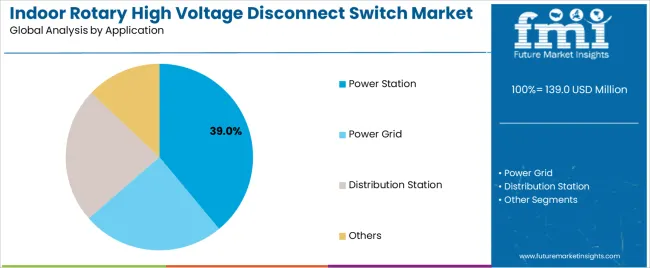
Power grid segment is projected to hold 39% of the indoor rotary high voltage disconnect switch market share in 2025. The segment's market leadership is driven by the extensive use of disconnect switches in transmission systems, substation applications, grid interconnection, and power distribution networks, where switching devices serve as both an isolation barrier and safety solution. The power grid sector's consistent demand for reliable switching equipment supports the segment's dominant position.
Market Context: Power grid applications dominate the indoor rotary high voltage disconnect switch market due to widespread adoption of reliable switching solutions and increasing focus on grid stability, fault isolation, and system protection that enhance power delivery while maintaining electrical safety standards.
Appeal Factors: Utility operators prioritize switching reliability, arc extinction capability, and integration with standard protection systems that enable coordinated deployment across multiple grid applications. The segment benefits from substantial infrastructure investment and grid modernization that emphasize reliable isolation systems for transmission and distribution applications.
Growth Drivers: Power system expansion programs incorporate disconnect switches as standard components for substation protection and grid reliability. At the same time, smart grid initiatives are increasing demand for advanced switching features that comply with automation standards and enhance system controllability.
Market Challenges: High voltage requirements and safety standardization may limit deployment flexibility in ultra-cost-sensitive markets or regions with varying electrical code requirements.
Application dynamics include:
Growth Accelerators: Grid modernization expansion drives primary adoption as disconnect switch systems provide exceptional isolation capabilities that enable power system protection without equipment failure, supporting electrical safety improvement and utility efficiency that require reliable switching formats. Infrastructure development accelerates market expansion as utilities seek dependable switching solutions that maintain system integrity during maintenance while enhancing operational safety through standardized isolation and protection compatibility. Technology advancement increases worldwide, creating sustained demand for arc-free switching systems that complement grid operations and provide operational advantages in power system reliability enhancement.
Growth Inhibitors: Raw material volatility challenges differ across electrical steel markets regarding price stability and supply chain consistency, which may limit margin predictability and cost planning in price-sensitive utility categories with demanding affordability requirements. Technical complexity persists regarding installation standards and maintenance protocols that may increase deployment costs in jurisdictions with strict electrical safety codes. Market fragmentation across multiple voltage specifications and switching standards creates compatibility concerns between different protection systems and existing power infrastructure.
Market Evolution Patterns: Adoption accelerates in utility and industrial sectors where reliability benefits justify equipment investments, with geographic concentration in developed markets transitioning toward mainstream adoption in emerging economies driven by electrification and power infrastructure development. Technology advancement focuses on enhanced switching properties, improved manufacturing precision, and integration with automated protection systems that optimize isolation performance and operational consistency. The indoor rotary high voltage disconnect switch market could face disruption if alternative switching technologies or regulatory changes significantly challenge traditional disconnect switch advantages in power system applications.
The indoor rotary high voltage disconnect switch market demonstrates varied regional dynamics with growth leaders including China (11.2% CAGR) and India (10.4% CAGR) driving expansion through grid modernization growth and power infrastructure development. Steady Performers encompass Germany (9.5% CAGR), Brazil (8.7% CAGR), and the USA (7.9% CAGR), benefiting from established electrical infrastructure and advanced switching technology adoption.
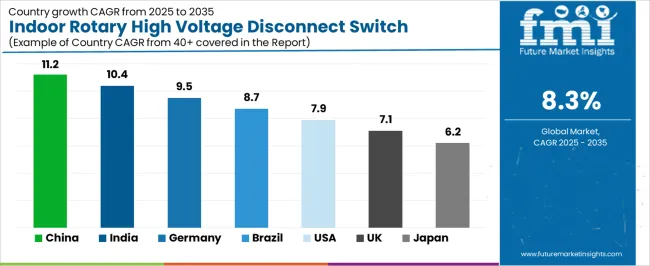
| Country | CAGR (2025-2035) |
|---|---|
| China | 11.2% |
| India | 10.4% |
| Germany | 9.5% |
| Brazil | 8.7% |
| USA | 7.9% |
| UK | 7.1% |
| Japan | 6.2% |
Regional synthesis reveals Asia-Pacific markets leading growth through infrastructure expansion and power system development, while European countries maintain strong expansion supported by grid modernization and environmental compliance requirements. North American markets show steady growth driven by utility infrastructure upgrades and industrial power system improvements.
China establishes regional leadership through massive power infrastructure development and comprehensive grid modernization, integrating advanced disconnect switch systems as standard components in transmission networks and industrial power operations. The country's 11.2% CAGR through 2035 reflects industrial growth promoting power demand and electrical infrastructure development that mandate the use of reliable switching systems in power distribution operations. Growth concentrates in major industrial regions, including Guangdong, Jiangsu, and Shandong, where transmission networks showcase integrated disconnect switch systems that appeal to grid operators seeking enhanced switching efficiency and international electrical standards.
Chinese manufacturers are developing innovative disconnect switch solutions that combine domestic production advantages with international quality specifications, including ultra-high voltage capabilities and advanced arc extinction technologies.
Strategic Market Indicators:
The Indian market emphasizes power system applications, including rapid grid expansion and comprehensive utility development that increasingly incorporates disconnect switches for transmission networks and industrial power applications. The country is projected to show a 10.4% CAGR through 2035, driven by massive electrification activity under power sector reforms and utility demand for standardized, high-performance switching systems. Indian power facilities prioritize cost-effectiveness with disconnect switches delivering operational reliability through economical equipment usage and dependable switching capabilities.
Technology deployment channels include major utilities, power generation companies, and industrial developers that support high-volume usage for transmission and distribution applications.
Performance Metrics:
The German market emphasizes advanced disconnect switch features, including innovative switching technologies and integration with comprehensive power management platforms that manage transmission operations, industrial applications, and renewable energy systems through unified switching systems. The country is projected to show a 9.5% CAGR through 2035, driven by grid modernization under energy transition trends and utility demand for premium, reliable switching systems. German utilities prioritize precision with disconnect switches delivering comprehensive power isolation through enhanced safety features and operational innovation.
Performance Metrics:
In São Paulo, Rio de Janeiro, and Minas Gerais, Brazilian utilities and industrial operators are implementing advanced disconnect switch systems to enhance power system capabilities and support operational reliability that aligns with electrical protocols and safety standards. The Brazilian market demonstrates strong growth with an 8.7% CAGR through 2035, driven by power sector expansion and utility investments that emphasize reliable switching systems for transmission and industrial applications. Brazilian power facilities are prioritizing disconnect switch systems that provide exceptional isolation properties while maintaining compliance with electrical standards and minimizing maintenance complexity, particularly important in utility transmission and industrial power operations.
Strategic Market Indicators:
The USA market emphasizes sophisticated disconnect switch deployment, growing at 7.9% CAGR, with documented operational excellence in transmission networks and industrial applications through integration with existing power management systems and reliability assurance infrastructure. The country leverages engineering expertise in electrical equipment manufacturing and switching technology to maintain market leadership. Utility centers, including California, Texas, and Florida, showcase advanced installations where disconnect switch systems integrate with comprehensive grid platforms and protection systems to optimize power distribution and operational efficiency.
American utilities prioritize switching precision and safety consistency in equipment selection, creating demand for premium disconnect switch systems with advanced features, including motorized operation and integration with automated protection protocols. The indoor rotary high voltage disconnect switch market benefits from established electrical infrastructure and willingness to invest in specialized switching technologies that provide superior isolation properties and regulatory compliance.
Market Intelligence Brief:
The UK market demonstrates meticulous disconnect switch deployment, growing at 7.1% CAGR, with comprehensive adoption across transmission networks and industrial power systems that emphasize electrical safety and operational reliability standards. British utilities are implementing advanced switching systems that comply with stringent electrical codes while providing enhanced isolation capabilities for power distribution and industrial applications. The indoor rotary high voltage disconnect switch market benefits from established electrical infrastructure and focus on safety standards that drive demand for premium disconnect switch solutions with certified performance characteristics and comprehensive testing documentation.
Performance Metrics:
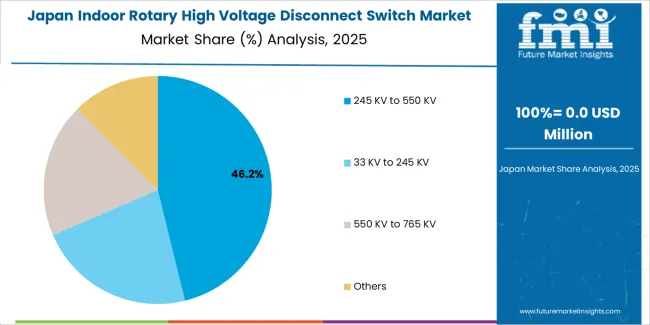
Japan's sophisticated power system market demonstrates meticulous disconnect switch deployment, growing at 6.2% CAGR, with documented operational excellence in utility networks and industrial applications through integration with existing power control systems and quality assurance infrastructure. The country leverages engineering expertise in electrical manufacturing and switching precision to maintain market leadership. Power centers, including Tokyo, Osaka, and Nagoya, showcase advanced installations where disconnect switch systems integrate with comprehensive power platforms and control systems to optimize electrical distribution and operational efficiency.
Japanese utilities prioritize switching precision and manufacturing consistency in equipment selection, creating demand for premium disconnect switch systems with advanced features, including compact designs and integration with automated power protocols. The indoor rotary high voltage disconnect switch market benefits from established power infrastructure and willingness to invest in specialized switching technologies that provide superior isolation properties and regulatory compliance.
Market Intelligence Brief:
The indoor rotary high voltage disconnect switch market in Europe is projected to grow from USD 38.7 million in 2025 to USD 79.2 million by 2035, registering a CAGR of 7.4% over the forecast period. Germany is expected to maintain its leadership position with a 32.8% market share in 2025, projected to reach 33.1% by 2035, supported by its power infrastructure excellence and major transmission centers, including North Rhine-Westphalia and Baden-Württemberg.
France follows with a 23.6% share in 2025, projected to reach 24.2% by 2035, driven by comprehensive utility programs and industrial facility initiatives. The United Kingdom holds a 19.4% share in 2025, expected to maintain 19.8% by 2035 through established transmission sectors and power system adoption. Italy commands a 13.7% share, while Spain accounts for 8.9% in 2025. The Rest of Europe region is anticipated to gain momentum, expanding its collective share from 1.6% to 2.2% by 2035, attributed to increasing power infrastructure development in Eastern European countries and emerging utility programs implementing standardized switching systems.
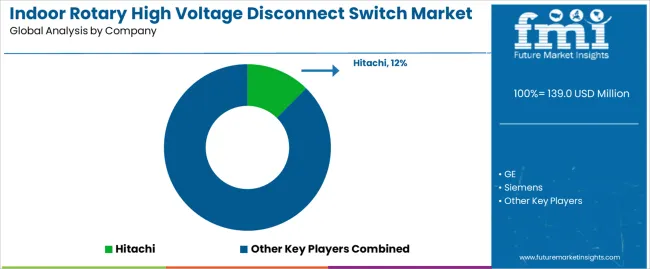
The indoor rotary high voltage disconnect switch market operates with moderate concentration, featuring approximately 15-22 participants, where leading companies control roughly 38-45% of the global market share through established distribution networks and comprehensive product portfolio capabilities. Competition emphasizes switching performance, manufacturing precision, and safety reliability rather than premium feature rivalry.
Market leaders encompass Hitachi, GE, and siemens, which maintain competitive advantages through extensive electrical manufacturing expertise, global distribution networks, and comprehensive technical support capabilities that create utility loyalty and support industrial requirements. These companies leverage decades of switching technology experience and ongoing electrical engineering investments to develop advanced disconnect switch systems with exceptional isolation and safety features.
Specialty challengers include SDCEM, Hapam, and Pfiffner, which compete through specialized application innovation focus and efficient manufacturing solutions that appeal to utility buyers seeking reliable performance formats and custom voltage flexibility. These companies differentiate through operational efficiency emphasis and specialized market focus.
Market dynamics favor participants that combine consistent switching performance with advanced manufacturing support, including automated assembly and testing capabilities. Competitive pressure intensifies as traditional electrical manufacturers expand into disconnect switch systems. At the same time, specialized switching converters challenge established players through innovative isolation technologies and cost-effective production targeting emerging utility segments.
| Item | Value |
|---|---|
| Quantitative Units | USD 139.0 million |
| Voltage Range | 33 KV to 245 KV, 245 KV to 550 KV, 550 KV to 765 KV, Others |
| Application | Power Station, Power Grid, Distribution Station, Others |
| Regions Covered | Asia Pacific, North America, Europe, Latin America, Middle East & Africa |
| Countries Covered | China, India, Germany, Brazil, USA,UK, Japan, and 25+ additional countries |
| Key Companies Profiled | Hitachi, GE, siemens, SDCEM, Hapam, Pfiffner |
| Additional Attributes | Dollar sales by voltage range and application categories, regional adoption trends across Asia Pacific, North America, and Europe, competitive landscape with electrical manufacturers and switching specialists, utility preferences for switching characteristics and safety performance, integration with power protection equipment and grid systems, innovations in arc extinction technology and motorized operation systems, and development of specialized switching solutions with enhanced isolation resistance and fail-safe features |
The global indoor rotary high voltage disconnect switch market is estimated to be valued at USD 139.0 million in 2025.
The market size for the indoor rotary high voltage disconnect switch market is projected to reach USD 308.6 million by 2035.
The indoor rotary high voltage disconnect switch market is expected to grow at a 8.3% CAGR between 2025 and 2035.
The key product types in indoor rotary high voltage disconnect switch market are 245 kv to 550 kv , 33 kv to 245 kv, 550 kv to 765 kv and others.
In terms of application, power station segment to command 39.0% share in the indoor rotary high voltage disconnect switch market in 2025.






Full Research Suite comprises of:
Market outlook & trends analysis
Interviews & case studies
Strategic recommendations
Vendor profiles & capabilities analysis
5-year forecasts
8 regions and 60+ country-level data splits
Market segment data splits
12 months of continuous data updates
DELIVERED AS:
PDF EXCEL ONLINE
Indoor Cable Assemblies Market Size and Share Forecast Outlook 2025 to 2035
Indoor Air Quality Monitor Market Size and Share Forecast Outlook 2025 to 2035
Indoor Location Market Size and Share Forecast Outlook 2025 to 2035
Indoor Space Heater Market Size and Share Forecast Outlook 2025 to 2035
Indoor Farming Market Analysis - Size, Share, and Forecast 2025 to 2035
Indoor Smokehouses & Pig Roasters Market – Smoked Meat Processing 2025 to 2035
A Detailed Global Analysis of Brand Share for the Indoor Farming Market
Indoor Residential Switchgear Market Size and Share Forecast Outlook 2025 to 2035
Smart Indoor Gardening System Market Size and Share Forecast Outlook 2025 to 2035
Family/Indoor Entertainment Centres Market Report – Forecast 2017-2027
Cat Condos & Indoor Houses Market Insights - Size & Trends 2025 to 2035
Rotary Tables with Torque Motor Drive Market Size and Share Forecast Outlook 2025 to 2035
Rotary Band Heat Sealer Market Size and Share Forecast Outlook 2025 to 2035
Rotary Heat Pump Compressors Market Size and Share Forecast Outlook 2025 to 2035
Rotary and RF Rotary Joints Market Size and Share Forecast Outlook 2025 to 2035
Rotary Drilling Rig Market Size and Share Forecast Outlook 2025 to 2035
Rotary Tool Market Size and Share Forecast Outlook 2025 to 2035
Rotary Scroll Air Compressor Market Size and Share Forecast Outlook 2025 to 2035
Rotary Tray Sealers Market Size and Share Forecast Outlook 2025 to 2035
Rotary Indexer Market Analysis - Share, Size, and Forecast 2025 to 2035

Thank you!
You will receive an email from our Business Development Manager. Please be sure to check your SPAM/JUNK folder too.
Chat With
MaRIA